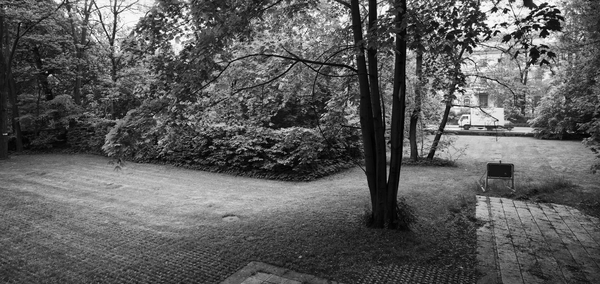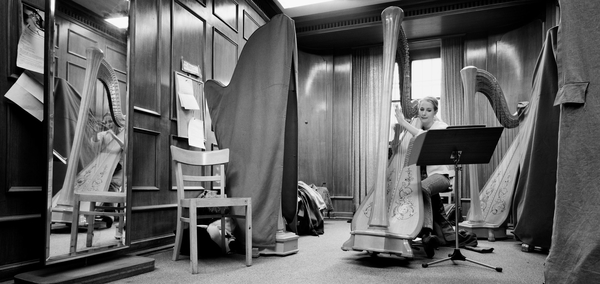Hidden City, 1994/2010
Hidden City (Nr. 1–28), 1994/2010
Hidden City (Nr. 1–28)
1994/2010
B/w photograph, inkjet print, variable dimensions
Edition 6 + 2 ap
The photo series Hidden City (1994/2010) embodies Julian Rosefeldt’s earliest work complex, Stadt im Verborgenen (Hidden City, 1994), that he developed together with his former artist-partner Piero Steinle for their diploma in architecture. Both works deal with the Königsplatz in Munich, where the headquarters of the NSDAP was located. Until just a few years ago, any information on the function and history of the buildings around the former cult and party centre of the Nazi movement was withheld from Munich’s citizens and visitors.
The work complex Stadt im Verborgenen consists of five parts: firstly, a photo installation that was shown only once at Munich’s Orangery; secondly, an architectural proposal for a documentation centre at the Königsplatz; thirdly, a film showing the caretaker of the University of Music and Performing Arts as he walks through a tunnel network between the bunkers underneath the former NSDAP buildings; fourthly, the publication Bürokratie und Kult (Bureaucracy and Cult), released by the artists in cooperation with the Zentralinstitut für Kunstgeschichte (Central Institute of Art History) on the occasion of the fiftieth anniversary of the end of World War II. Finally, Rosefeldt and Steinle developed an information board that for a long time represented the only attempt to bring the past of the Königsplatz – the situation and former function of its buildings during the era of National Socialism – to light. This certainly contributed to an ongoing discussion, which led to the actual realisation of a documentation centre on site.
Hidden City consists of twenty-eight black-and-white photographs, and is a new anthology from the pictures taken by Rosefeldt in 1994/1995, released in the catalogue Bürokratie und Kult. At the time, Rosefeldt and Steinle questioned the fake picture given by their hometown Munich to its visitors by hiding a dark history behind perfect-looking facades. Focussing on the still existing buildings of the former NSDAP headquarters, they revealed an almost forgotten catacomb system beneath. The major part of the subterranean network of tunnels and bunkers has remained structurally unchanged to this day. At street level, the artists unmasked the pedestals of Hitler’s so-called ‘Ehrentempel’ (temples of honour), which had been simply hidden behind bushes and thus rendered invisible to the public. The series offers a look into hidden places and secret absurdities discovered by Rosefeldt and Steinle, while also tracing the past: graffiti from the Allies, traces of soldiers’ dalliances with the ‘ladies’ (i.e. prostitutes), and finally a personal party room that the caretaker of the University of Music and Performing Arts installed at Hitler’s private bunker.
L. Korndörfer
Exhibitions / Catalogues
– Conflict, Time, Photography, Museum Folkwang, Essen, April 10–July 5, 2015; Tate Modern, London,
November 26, 2014–March 15, 2015 (curated by Simon Baker; catalogue)
– Julian Rosefeldt – Meine Heimat ist ein düsteres, wolkenverhangenes Land, Arndt Berlin, July–August 2014
– Julian Rosefeldt – Living in Oblivion, Berlinische Galerie, Berlin, May–October 2010 (curated by
Guido Fassbender, Heinz Stahlhut; catalogue)
– Dark Places, Santa Monica Museum of Art, January–April 2004 (curated by Joshua Decter)
Rosefeldt, Julian and Steinle, Piero, eds. Bürokratie und Kult. Das Parteizentrum der NSDAP am Königsplatz in München. Munich / Berlin, 1995.




























